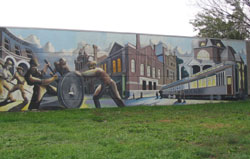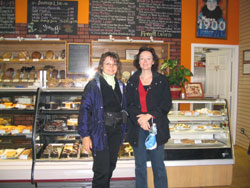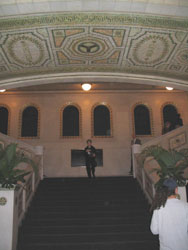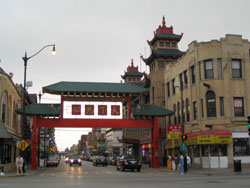After being appropriately prepped as a result of our visit to the Chicago Cultural Center we decided to head off yesterday to visit the Pullman Historic District, a planned industrial and residential community dating back to the 1880s, on Chicago’s South Side.
In order to get there we took the red line all the way to the end and then connected onto the 111 bus. What was very interesting to note was that the population on Chicago’s south side is predominantly black, as much of the black population from the US South had migrated northwards after the 2nd World War. Actually Chicago was known as one of the most racially segregated cities, and today, with the demolition of many of the bleak urban housing projects, the city is attempting to create more integration between its black and white population.
The Pullman Historic District is the manifestation of a very interesting social experiment: It was built between 1880 and 1884 as a planned model industrial town by George M. Pullman for the Pullman Palace Car Company. George Pullman (1831 to 1897) arrived on the scene with a design for the Pullman sleeping carriage which he originally developed to carry the dead body of Abraham Lincoln to his funeral. As a result the Pullman Sleeping Car Company was established and a whole town was built around the business and named after its originator.

Mural in the Pullman Historic District
We went to the Visitor Center and saw an 18-minute movie that described George Pullman and his ambitious plans for his development of a model community, a total environment, that he intended to be superior to that available to the working class elsewhere. By so doing, he hoped to avoid strikes, attract the most skilled workers and attain greater productivity as a result of the better health and spirit of his employees.
To achieve his vision, George Pullman hired Solon S. Beaman, landscape architect Nathan F. Barrett and civil engineer, Benzette Williams. The town was constructed by Pullman employees, using local red clay from Lake Calumet and component parts that were produced in the Pullman factory. This project is one of the first examples of industrial technology and mass production in large-scale housing. The town was a complete planned community and included schools, a library and hotel all run by the company.
Pullman’s large Arcade building (now demolished and the present location of the Visitor Center) featured a restaurant, a bank, a library, a post office, a theater, and numerous shops. It was a forerunner of the modern shopping center. The town was completely self-contained. Pullman residents enjoyed the manmade Lake Vista and plenty of parks and promenades, features typically missing from Chicago’s working-class neighbourhoods.

Tidy row houses
The town of Pullman was a model of financial efficiency. Pullman demanded that the company return an 8-percent profit and the town return a 6-percent profit. A huge engine pumped sewage from the town to a nearby Pullman-owned farm, where it was used as fertilizer for produce that would be sold back in the town.
George Pullman maintained ultimate control over the town, even restricting workers’ access to alcohol, as the Hotel Florence only sold alcohol to out-of-town visitors. Resentment towards this paternalistic despot started to build. Misfortune struck with the decline of the Pullman car’s success which forced George to slash wages. Workers responded with a strike, fuelled by Pullman’s failure to reduce grocery costs and rent, but George simply fired them. The situation deteriorated as railway workers refused to handle Pullman cars and President Cleveland had to intervene, sending federal troops to the scene. The workers were forced to sign documentation declaring that they wouldn’t join a union.
Although the strike collapsed, George Pullman’s model for handling the “labour problem” had failed. Pullman had prided himself on his paternalistic approach with his workers, and he could not see how his heavy-handed methods had resulted in this worker rebellion. Criticized and scorned, Pullman died a bitter man in 1897.

Hotel Florence



